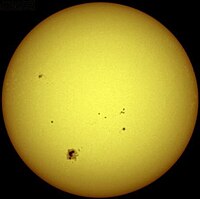Portal:Astronomy/Featured/July 2006

The Sun is the star at the center of Earth's Solar System. The Earth and other matter (including other planets, asteroids, meteoroids, comets and dust) orbit the Sun. The Sun accounts for more than 99% of the solar system's mass. Energy from the Sun has supported almost all life on Earth through photosynthesis since the appearance of the first organisms. Humans use sunlight for eyesight, warmth, growing crops, and powering solar cells. Heat generated by sunlight (insolation) drives climate and the weather cycle on Earth.
About 74% of the Sun's mass is hydrogen, with 25% helium, and the rest is made up of trace quantities of heavier elements. The Sun is about 4.6 billion (109) years old and is about halfway through its main sequence evolution, during which nuclear fusion reactions in its core fuse hydrogen into helium. About 5 million tons of matter are converted into energy within the Sun's core every second, producing neutrinos and solar radiation. In about 5 billion years, the Sun will evolve into a red giant and then a white dwarf, creating a planetary nebula in the process.
Although it is the nearest star to Earth and has been intensively studied by scientists, many questions about the Sun remain unanswered, such as why its outer atmosphere has a temperature of over 1 million K when its visible surface (the photosphere) has a temperature of just 6,000 K. Current topics of scientific study include the sun's regular cycle of sunspot activity, the physics and origin of solar flares and prominences, the magnetic interaction between the chromosphere and the corona, and the origin of the solar wind.
Recently featured: Planetary nebula – Comet Hale–Bopp – Galileo Galilei
| ...Archive | Read more... |
